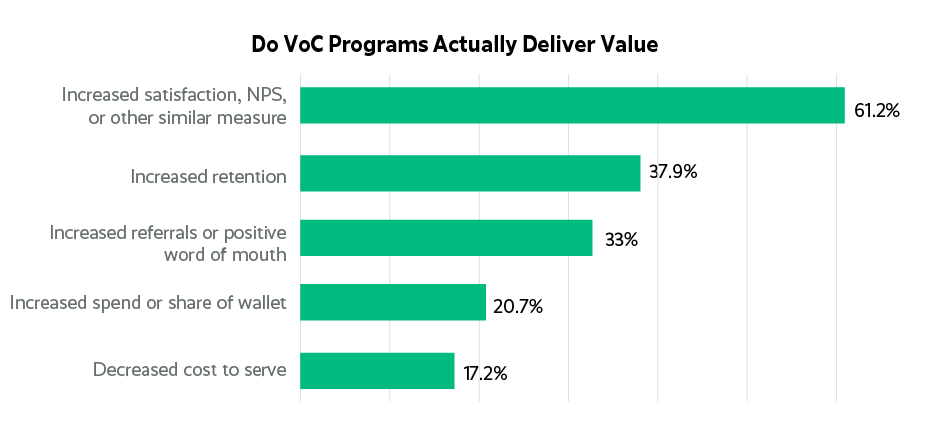Voice of the Customer: Your Secret Weapon to Strengthen Customer Service
The foundation of a successful business relies on its customers. Simply coasting through without hearing feedback from them will most likely lead to misfortunes financially. Any business that suffers in that regard probably won’t be around for too long.
Customer service feedback is important to any business. It helps build the company and improves customer loyalty – both of which will help keep the client invested in your services.
However according to a recent blog via Hubspot, an astonishing 42% of businesses don’t survey or collect feedback from their customers. The article goes on to say many businesses say they’re customer first, but only 12% of customers believe that.
For nearly all companies, their front-line source to collect customer service feedback is through their contact centers. Agents are the first to connect with customers and listen to what they have to say.
While agent-customer interaction is important, the best way to further connect and get quality customer service feedback is through the Voice of the Customer or VoC. Voice of the Customer is an in-depth process of capturing customer’s expectations, preferences, likes, and aversions. VoC is a research technique that produces a detailed set of customer wants and needs, organized into a hierarchical structure, and then prioritized in terms of relative importance and satisfaction with current alternatives.
Having a VoC product allows businesses to better understand their customers and therefore make more informed decisions that align with the needs of their customers.
Five Reasons VoC is Important for Businesses
1. Improve Customer Experience
Gathering information through VoC surveys centered around Customer Satisfaction (CSAT), Customer Effort Score (CES) and Net Promoter Score (NPS) can help a business gain knowledge of what exactly the customer wants.
If you’re looking to improve, say in the area of customer orders, you can focus a survey on the ordering process, the speed of the order, or delivery.
Be sure to keep it simple with multiple-choice questions and don’t take up too much of the customer’s time. Customers don’t want to spend endless amounts of time taking a survey, unless there are one of two factors — either the customer is really irate about a situation and will give the company an extremely low score or one that only answers extremely high, and if that happens initially, take it with a grain of salt. You want to be good, but know from the outset there are ways to improve.
On that point, a company should target straightforward responses to acquire the “right stuff” in their answers. Find the middle ground and build on those responses to improve your company.
As a post-script to this subject, before your agents send the VoC survey for customer service feedback, always let the customer know a survey will be coming. Preparing them is another valuable step toward improving your customer experience.
2. Manage Brand-Customer Perception
To get an idea of what customers think of your company as a brand, you can send a Brand Perception Survey. In the minds of customers or prospects or other stakeholders, this will give you an idea of how your brand is perceived. A brand is an idea connected to the product or service. For example, car sharing company Turo markets itself as way better than a rental car.
To develop a brand, or improve on the brand you already have, hearing what customers have to say about your business is the best way.
Four human factors come into play when leading to brand affinity:
- Cognitive – the concepts that a consumer associates with your brand
- Emotional – the feelings that a consumer associates with your brand
- Language – how a consumer describes your brand
- Action – the experiences a consumer has with your brand
For cognitive, perhaps ask the survey question, “When you think of [your brand], what comes to mind first?” For emotional try, “What kind of feelings do you experience when you think of [your brand]?” For language, how about “Which three words would you use to describe [your brand]?” and for action “How would you describe your last experience with [your brand]?”
The results are tools to understand how effective your marketing and messaging can be. More importantly, the questions answered can be a guide to see if your product experience matches your brand values.
3. Increase Revenue
VoC is more than discovering if your company is providing the best in customer experience, it’s also a powerful tool as a revenue generator as well.
The base of your business is your customers and getting their VoC feedback gives you insight on what your customers value the most. Beyond that, understanding how to improve upon those customer experiences can help in structuring your Go-To-Market, upsell, and cross-sell strategies.
A recent blog outlined a study that concluded that collecting customer feedback can increase upselling and cross-selling by 15 to 20%.
If a company focuses on what its existing customers have to say that makes customer retention the highest of priorities. Delivering that value to its customers will only generate more revenue.
Selling to an ongoing customer is in the neighborhood of 60 to 70%, while the probability of selling to a new prospect is 5-10%.
Existing customers are 50% more likely to try new products and spend 31% more, when compared to new customers.

Source: SuperOffice.com
4. Increase Loyalty
It’s obvious that taking VoC feedback will help in many facets, but acting on that feedback shows the company listens to its customers, appreciates them, and in turn their loyalty will grow.
In the graphic above, a 37.9% increase in customer retention is a huge jump for any company, no matter how large or small the business is.
Take that retention and advance VoC a little further to get more data on hand. By asking a Net Promoter Score (A 0-10 scale) question like “How likely are you to recommend our service to a friend or colleague?” will provide valuable information for your business in gaining new customers (and hopefully further retention from the new customers).
5. Use Information for Marketing Campaigns
Data from VoC can be a big benefit to your marketing campaigns as it can tell which ones are working and which are not.
Identify opportunities for messaging and marketing by formulating VoC questions that address opportunities. For example:
- “What made you buy our product the first time?”
- “What features do you like about our product?”
- “Did our product deliver as expected?”
- “What are the top three reasons you chose our product instead of another supplier?”
Take those answers and find a common theme. In the question asking for reasons you chose our product over the competition, if the underlying theme was quality at a lower price, then build an email marketing campaign around that.
The same goes for a social media campaign saying you have the better product for better cost.
Conclusion
The bottom line is don’t just do the surveys for the sake of doing it, follow up and act on it.
Taking the VoC feedback a company receives and using it to an advantage will increase the level of which the business operates. It also means a business who goes by the trademark of “customer first” will better prove to its customers that the label is true.









